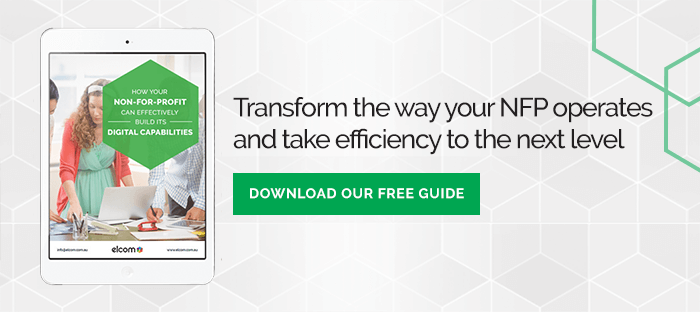When the greater good directly depends on your organisational success, the stakes can be high for implementing new technology.
But what we’re finding is that not-for-profit organisations are some of the most active adopters of emerging and innovative technology.
4 key technology trends in not-for-profit organisations
The current landscape of the Australian non-profit sector is anything but stagnant. It’s evolving, innovating, and transforming, all powered by technology and the growing need for digital agility.
1. Digital Adoption On The Rise
The Salesforce Nonprofit Trends Report highlights a significant trend of increasing digital adoption amongst Australian NFPs. The report reveals that a substantial 73% of these organisations have amplified their use of digital tools over the past year.
This trend is not without reason. With the remote work environment becoming a new norm, it has become imperative for NFPs to stay connected and maintain their operations seamlessly. Digital tools facilitate this by offering remote work capabilities.
With the escalation of data management demands, the need for comprehensive and effective digital tools has grown more than ever.
Additionally, a shift towards digital engagement has been observed within the sector. As the world moves online, so do our interactions. It’s now essential for NFPs to digitally connect with donors and beneficiaries, particularly through NFP web design projects, to keep the engagement levels high.
2. The Challenges: Data Management and Digital Skills
While the digital era brings numerous advantages, it also brings forth challenges that NFPs need to grapple with. Notably, over 60% of NFPs, as per the Salesforce report, are struggling with managing data. When data is scattered across multiple platforms, it becomes a daunting task to track, manage, and derive valuable insights from it.
In addition to data management, another challenge that emerged is a considerable skills gap in effectively using digital tools. Nearly 50% of Australian NFPs have reported this problem, highlighting the urgent need for adequate digital skills training within the sector.
3. Tackling Challenges with Integrated Tech Solutions
Despite these challenges, technology itself offers the solution, particularly through integrated technology solutions. Integrated tech platforms are those that consolidate various functionalities into a single, accessible platform. These technologies can manage an NFP's data more effectively by providing a consolidated view, making it easier to derive actionable insights.
The Salesforce report also states that 77% of high-performing NFPs have effectively utilised these integrated tech solutions, streamlining their data management, improving efficiency, and enhancing their ability to engage digitally with stakeholders.
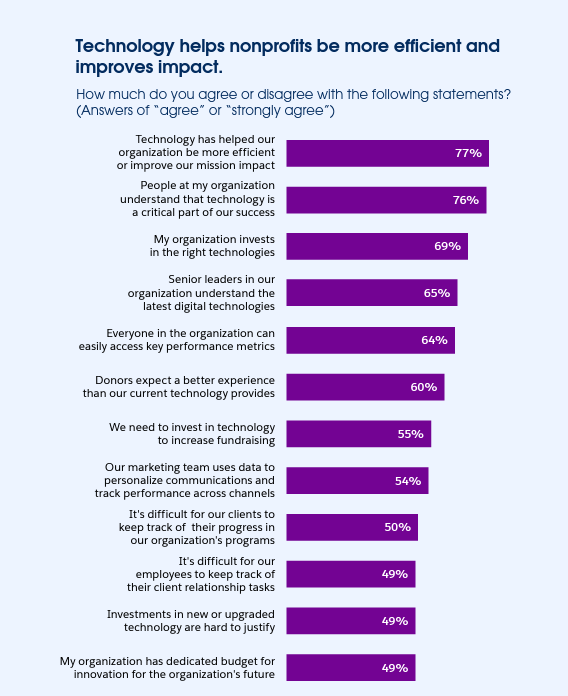
This increasing reliance on integrated tech solutions among NFPs is indeed a testament to their efficacy. However, to fully utilise these technologies, NFPs must address the skills gap within their organisations. This could involve investment in comprehensive training programmes or partnering with digital experts.
4. Trust and transparency has become paramount
According to the McCrindle Australian Communities Trends Report, 66% of Australians say that their trust and knowledge of an organisation is the most significant factor when they make a decision to get involved with a certain not-for-profit or charity.
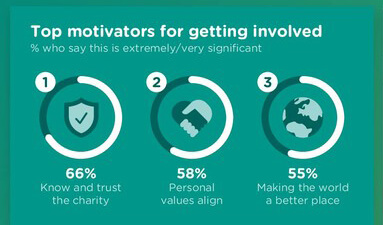
Survey respondents said transparent reporting of administration costs is the most important characteristic for a charity to have, at a whopping 69%. As such, quality information and data security will be key focal points moving forward.
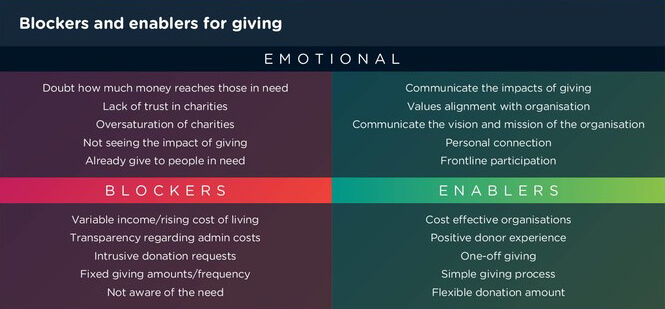
5. Almost half of not-for-profits feel they’re due for a website upgrade
41% of not-for-profits said improving their website is a top priority, according to a report called Digital Technology in the Not-for-Profit Sector.
And this priority makes sense: with increasing pressure from government departments, donors and stakeholders for greater transparency about where funds are allocated, a website and potentially an integrated portal can be one of the single best ways to communicate with the wider world and gain donations.
A significant 43% of online donations are collected through direct website e-commerce.
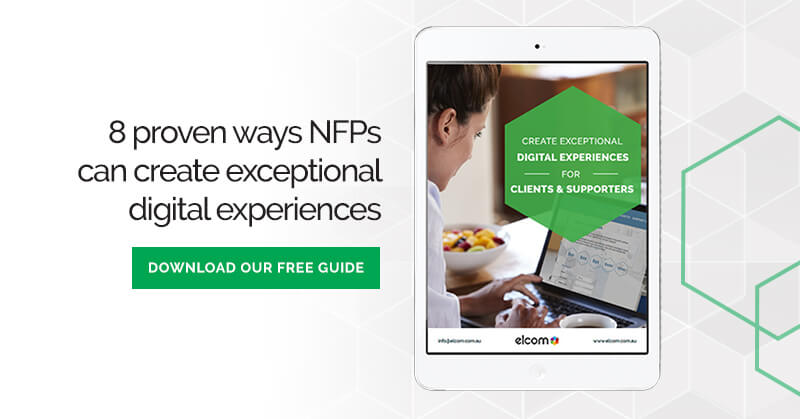
4. Improving the digital capabilities of staff continues to be a priority.
The same report called Digital Technology in the Not-for-Profit Sector, found that organisations are continuing to focus on improving the digital capabilities available to their workforce.
Digital technologies streamline and simplify processes enabling staff to deliver better and improved client outcomes and experiences.
This includes having the technology infrastructure and systems in place so staff can collaborate and work productively regardless of where they are working on a given day.
Not-for-Profit Challenges – and the Technological Solutions
Challenge #1: Separate and segmented departments
When you’re working towards a common goal, it makes sense for departments to work together using the same files, documents and data. But disconnected departments are a common problem in the not-for-profit sector, leading to wasted time and opportunities. This also stops teams from seeing the overall benefit of their work; just 44% of not-for-profits say that their primary system enables them to understand the impact of services and outcomes.
The solution: Cross-department visibility and a single source of truth.
By using a central interface on your intranet, employees are able to work from home with access to online forms and data with accurate version control. Employees can search for and find the information they need quickly, work across various locations and time zones, and easily check in with the progress or outcomes for their clients.
Each department can have their own section on the intranet with policies, procedures, forms, documents and other information. You can also create resource hubs for specific topics such as working from home that's accessible from different locations and devices.
Further reading: [Blog post] How to Boost the Employee Experience During a Crisis
Anglican Care has been operating since 1956 and has an outstanding reputation for the quality of care provided by our skilled and caring staff.
They have assessors who visit their residential sites on a regular basis unannounced. They sift through every part of the organisation and their staff need to be responsive in providing them with information from different departments. This is made more challenging when agency staff are rostered who may not know where to find information.
With the intranet, they are able to house all the needed information in in a central online area on their intranet. And to have it all housed in one searchable repository that is accessible to all staff on site is invaluable for the team.
Challenge #2: Outdated communication processes
Only 30% of not-for-profits in Australia and New Zealand had all the systems and software needed for staff to work from home during COVID-19.
It’s now abundantly clear that communication and collaboration is needed for an adaptive, connected and resilient organisation.
The solution: Activity-based collaboration tools and integrated communication.
Not-for-profits can centre communication and collaboration around activities and projects with the right intranet solution, which makes discussion intuitive even via mobile and remote access. This can be a formal workspace via team workspaces or a more informal tool such as social Q&A which can be open to all or select staff to contribute and share their ideas.
Personalising the experience for different users via location, department and job roles is also encouraged. This makes it easy for users to find what they need quickly and efficiency, while improving communication and transparency. Improved communication can also:
- Help the workplace culture to thrive
- Actively encourage two-way communication with management, and
- Open up discussion for innovative ways to support the not-for-profit’s cause.
Consider personalising the navigation menu and sections users can view, quick links, links to relevant external tools, news feeds and any integrations.
Northcott, for example, is one of Australia’s largest not-for-profit disability service organisations. Their Early Childhood Early Intervention (ECEI) team work in centres away from head office and team workspaces gives them a dedicated area to collaborate. Prior to this, everything was done via email which was not an efficient means of communication.
It features relevant policies and procedures, a calendar, key contacts, tools, related resources and a forum to share and request information from each other. Key metrics such as the number of children seen and plans completed, are also prominently displayed on the page to highlight the positive work the team have done.
Challenge #3: Manual processes are slowing key activities down.
In a sector where funds and resources can be precious, manual processes are still leading to plenty of waste for not-for-profits. Key areas are:
- Form and donation processing
Both internal and external forms can have confusing and lengthy processing procedures, which can in turn stop help from going where it’s needed.
- Training and professional development
Training and skill development is a major challenge for not-for-profits. Lack of skills account for 39% of the challenges that not-for-profits face in adapting to opportunities and threats, while a lack of human resources and personnel counted for 28%.
The solutions: Efficient workflow management and eLearning technology.
Both workflow management and internal training can be optimised with the right technology, which can guide a user through the next steps necessary. These processes can be set up with very minimal IT knowledge required, democratising and demystifying the digital management process.
For example, when a new client submits an application form, it requires processing and actions from several departments and include a request form the organisation for NDIS funding. This process can be automated via online forms and advanced workflows.
When staff need additional training, especially while working remotely, an eLearning solution ensures they can receive adequate training while tracking their progress.
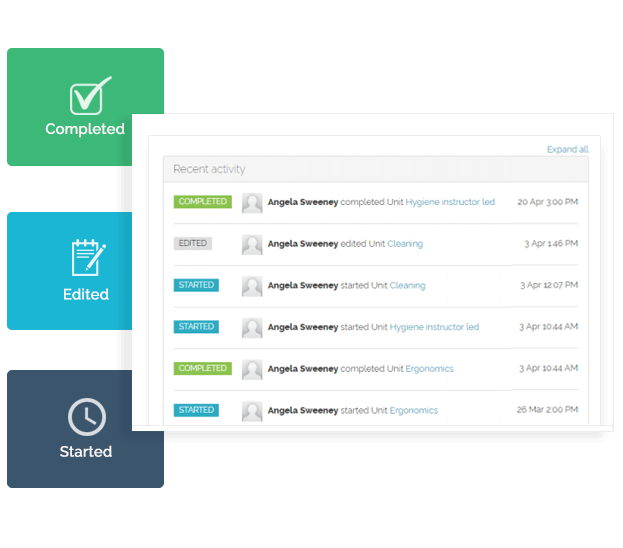
Effective eLearning provides clear next steps.
Medical Indemnity Protection Society (MIPS) is a not-for-profit organisation formed to provide healthcare professionals and students with the security and support they need to practice with confidence.
MIPS implemented a website with a member portal and training capabilities. Elcom's Training Manager provided an effective platform to deliver MIPS’ initial business needs and a path forward for enhanced development. New features were also added including the implementation of automated email, SMS alerts and risk education dashboard to enhance the training experience for members.
Further reading:
Challenge #4: Security and compliance is always a key consideration.
There’s no doubt that data security is an essential consideration for every not-for-profit, but many organisations see this as easier said than done. For 33% of large not-for-profits who don’t use cloud technology, data security and data privacy concerns are seen as a key barrier. And 46% of not-for-profits have no way of actively monitoring information security and cyber risks. The rise in remote and hybrid working and BYOD can introduce new security threats.
The solution: Enhanced security functionality from a reliable technology provider.
Software providers regularly release updates to stop new threats and security vulnerabilities. Ensure that you are on top of security updates and patches from your provider. Ideally, you will have an Account Manager who can inform you when an update is available.
It is also a good idea to set up access permissions for different groups of users within the different technology you use. Security permissions and access levels also help to control the internal flow of data and limit access to sensitive data. Many providers offer two-factor authentication which means staff need to use both their logins and another form of identification, such as a code sent to their mobile phone, in order to access the system.
Cabrini is a private, not-for-profit, Catholic health service. They made sure to set up security and user-group permissions when their intranet went live.
As a health organisation, they needed secure and private sections to house confidential information for only a select number of staff to view. To gain access, staff need to fill in an online form which is emailed to the appropriate person for approval.
Challenge #5: Failing to act until it’s too late.
Internal resistance to change is seen as a challenge to adaptation for 36% of surveyed not-for-profit organisations. It’s only natural to feel this way – as any step backwards could mean fewer funds going towards a vital cause!
But not-for-profits who are innovation-active have a rosier future outlook over those who are still improving their innovation. Innovative not-for-profits feel their staff can focus better on customer care (52% versus 39%) and feel far less likely to fail over the next 3-5 years (28% versus 46%).
The solution: Assess unique needs and objectives, and create a digital transformation plan.
A thoughtful IT plan and successful implementation of new technologies can put your resources to greater use, and create a future where you feel fully equipped to adapt to new threats and opportunities.
Moving ahead with a more efficient, collaborative and streamlined digital workplace and web presence will empower not-for-profits to make the most of every donation, grant and contribution – and ultimately, help more people.
Further reading: [Blog post] The Secrets to a Successful Digital Strategy for Not-For-Profits (NFPs)
Keen to learn more?
Digital technology presents exciting opportunities for not-for-profit organisations to support workers in their roles and improve service delivery to stakeholders.
Yet, only 7% of NFPs are taking full advantage of their digital capabilities.
In this guide, we explore how NFPs can effectively (and realistically) build the capability and infrastructure needed to take efficiency and productivity to the next level.
The Elcom team has worked with several NFPs over the years and distilled these insights into this informative guide.
